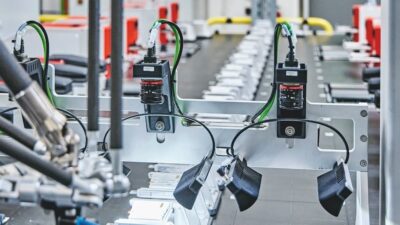Motion control, as other technologies, has its fair share of special terms. Not all of them are rigorously defined; some require blending to suit the specific audience. Here's a sampling of some well-known and not-so-well-known terms.A motion control system typically consists of a controller to process motion algorithms and signals; an amplifier to boost signals to a level needed to p...
Motion control, as other technologies, has its fair share of special terms. Not all of them are rigorously defined; some require blending to suit the specific audience. Here’s a sampling of some well-known and not-so-well-known terms.
A motion control system typically consists of a controller to process motion algorithms and signals; an amplifier to boost signals to a level needed to power an actuator that provides the motion output; and feedback (sensors/transducers) to allow adjustments for process changes, based on comparing measured output with the input.
An operator interface or host terminal front-end completes the system. Feedback implies that most motion control systems operate in closed-loop ; however, some run in open-loop , notably a step-motor-based system. Actuators come in various forms—motors, cylinders, solenoids, etc.—and can be electric, hydraulic, pneumatic, or other type.
Axis —Any movable part of a machine or system that requires controlled motion. Several axes of motion can be combined in a coordinated multiaxis system.
Circular interpolation —Coordination of two independent motion axes to produce an apparent circular motion. It’s done through a series of straight line approximations via software algorithms.
Commutation —Sequential excitation of motor windings to maintain the relative phase angle between the rotor and stator magnetic fields, within specified limits, to control motor output. In brush dc motors, this function is accomplished by a mechanical commutator and carbon brushes; in brushless motors, it’s done electronically using rotor position feedback.
Electronic gearing —A method that simulates mechanical gears by electrically “slaving” one closed-loop axis to a second axis (open- or closed-loop) through a variable ratio.
Encoder —A feedback device that translates mechanical motion into electrical signals indicative of actuator position. Incremental and absolute encoders are common varieties; as the names imply, their output indicates incremental or absolute changes of position.
Feedforward —A method that “precompensates” a control loop for known errors due to motor, drive, or load characteristics to improve response. It depends only on the command, not the measured error.
Indexer —An electronic unit that converts high-level commands from a host computer, PLC, or operator panel into step and direction pulses needed by a stepping motor driver.
Loop bandwidth —Maximum rate at which a control loop can respond to a change in a control parameter. It’s indicative of loop performance and is expressed in Hertz (Hz).
Motion profile —The velocity versus time (or position) relationship of the move made by a motion axis. See diagram for two common, though unrelated, types of motion profiles.
Overshoot —A system response where the output or result exceeds the desired value.
Pulse-width modulation —A switch-mode control method used in amplifiers and drivers to control motor voltage and current to obtain higher efficiency than linear control. PWM refers to variable on/off times (or width) of the voltage pulses applied to the transistors.
Quadrature —A technique that separates signal channels by 908 (electrical) in feedback devices. It is used with encoders and resolvers to detect direction of motion.
Resolver —A position transducer that uses magnetic coupling to measure absolute shaft position during one revolution.
Servo mechanism —An automatic, closed-loop motion control system that uses feedback to control a desired output such as position, velocity, or acceleration.
Tachometer —An electromagnetic feedback transducer providing an analog voltage signal proportional to rotational speed.
This sampling of terms draws on various sources, notably, Programmable Motion Control Handbook (1992) , National Electrical Manufacturers Association (Washington).



